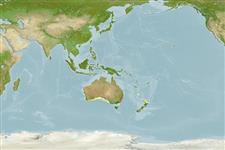>
Gobiesociformes (Clingfishes) >
Gobiesocidae (Clingfishes and singleslits) > Cheilobranchinae
Etymology: Cochleoceps: Greek, kochlea = snail like + Latin, ceps, caput = head (Ref. 45335).
Environment: milieu / Klimaatzone / Diepte / distribution range
Ecologie
marien demersaal; diepte 3 - 40 m (Ref. 9002). Subtropical
Southwest Pacific: New South Wales and eastern Victoria, Australia.
Grootte / Gewicht / Leeftijd
Maturiteit: Lm ? range ? - ? cm
Max length : 5.5 cm TL mannelijk / geslacht onbekend; (Ref. 9002)
Korte beschrijving
Determinatiesleutels | Morfologie | Morfometrie
Dorsale stekels (totaal) : 0; Dorsale zachte stralen (totaal) : 5 - 6; Anale stekels: 0; Anale zachte stralen: 4 - 6. Caudal fin rounded (Ref. 9002). Pelvic fins united into moderate-sized double sucking-disc, posterior half with a fleshy fringe (Ref. 9002). Greenish-yellow to orange with small scattered dark spots to larger red spots, variable in density; iridescent blue dashes or lines dorsally and across sides over head and body (Ref. 9002).
Body shape (shape guide): elongated.
Adults usually on kelp, on which they deposit their eggs, which are guarded by the male, although the female is often present as well (Ref. 9002). Often on ascidians or sponges in deep water, probably depositing eggs on algae nearby (Ref. 9002). Often observed cleaning boxfishes, porcupine fishes and morwongs (Ref. 9002).
Levenscyclus en paargedrag
Maturiteit | Voortplanting | Paaien | Eieren | Fecunditeit | Larven
Kuiter, R.H., 1993. Coastal fishes of south-eastern Australia. University of Hawaii Press. Honolulu, Hawaii. 437 p. (Ref. 9002)
Status op de Rode Lijst van het IUCN (Ref. 130435: Version 2025-1)
Gevaar voor de mens
Harmless
Gebruik door de mens
Tools
Speciale rapporten
Download XML
Internetbronnen
Estimates based on models
Preferred temperature (Ref.
123201): 16.4 - 23.3, mean 18.2 °C (based on 72 cells).
Fylogenetische diversiteitsindex (Ref.
82804): PD
50 = 0.5312 [Uniqueness, from 0.5 = low to 2.0 = high].
Bayesian length-weight: a=0.00389 (0.00180 - 0.00842), b=3.12 (2.94 - 3.30), in cm total length, based on all LWR estimates for this body shape (Ref.
93245).
Trofisch niveau (Ref.
69278): 3.2 ±0.3 se; based on size and trophs of closest relatives
Weerstandsvermogen (Ref.
120179): Hoog, minimale populatieverdubbelingstijd minder dan 15 maanden (Preliminary K or Fecundity.).
Fishing Vulnerability (Ref.
59153): Low vulnerability (10 of 100).
🛈
Nutrients (Ref.
124155): Calcium = 282 [138, 664] mg/100g; Iron = 1.45 [0.79, 2.77] mg/100g; Protein = 17.3 [16.2, 18.5] %; Omega3 = 0.332 [0.174, 0.648] g/100g; Selenium = 14.9 [6.4, 39.9] μg/100g; VitaminA = 47.7 [12.5, 172.0] μg/100g; Zinc = 1.53 [0.98, 2.36] mg/100g (wet weight);
